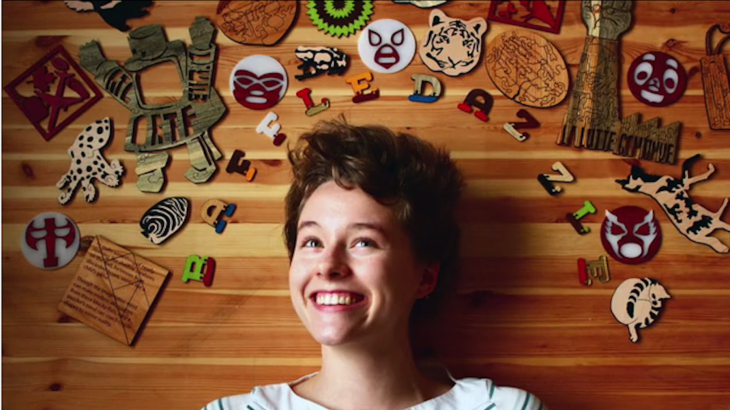Rachel Happen graduated from the University of Utah in 2011 with a degree in entrepreneurship from the David Eccles School of Business and one startup under her belt: semifold, a purveyor of “difficult clothing.” Rachel now resides in Portland, Oregon and has recently started a second company, Baffledazzle. She recently sat down with the Lassonde Entrepreneur Institute for an interview. We’ve pulled out some highlights to share with you.
Tell us a little bit about your current project, Baffledazzle.
Baffledazzle is an adventure-in-a-box puzzle series.
Baffledazzle puzzles combine solid wood jigsaw puzzles with clever riddles that lead solvers on a quest to uncover the story that lives beyond the images and shapes in the puzzle. Every puzzle leads you to something real: a moment in history, a scientific discovery, a hidden culture, a tradition forgotten by time or even an ancient joke. The goal is to make the end enlightening and the journey worth it. I am currently running a campaign on Kickstarter to support Baffledazzle’s growth.
How did you get from Baffledazzle from semifold — the company you founded while attending the University of Utah?
My previous company, semifold, strove to deliver “difficult clothing” that challenged wearers to think, act and move in new ways. It was born from my background in dance and my partner’s background in fine arts. We were both looking for new ways to share experiences with others, so we chose to create clothing and footwear because it was interactive by definition and so closely associated with self-expression.
Baffledazzle is a natural extension of the work I did with semifold. I’m passionate about cultivating experiences worth sharing and packaging them into products that can be touched, owned and shared. I’ve been “doing” for years, but I never really left “thinking” behind! I’m always looking for ways to improve my work and considering how to turn those ideas into new ventures.
“People ask all the time how I got started with puzzles. I just started! There is no ‘how.’ You figure that out as you go. There is no wrong first step.”
What were the first steps you took to make Baffledazzle a reality?
I just started making puzzles. I learned everything I could about laser cutting (I even got this encyclopedic book from the library about manufacturing techniques to see if there was any method more suitable, turns out laser cutting was best), then I found a bunch of local workshops that had laser cutters. There was a lot of trial and error finding a place that could deliver high-quality laser work, and developing my puzzle-designing abilities to the point where I could make something presentable.
That first stage — where you’re just making prototype after prototype and you’re not sure if they’re getting better or going in the right direction — is a really difficult time for a new venture. I had more than one puzzle design (which I had spent over a month developing), simply not work on the laser. I just had to scrap it and move on. The first few steps of turning any idea into reality may feel like a dozen identical sideways steps. Don’t worry! You are making progress!
“The first few steps of turning any idea into reality may feel like a dozen identical sideways steps. Don’t worry! You are making progress!”
What has been, for you, the most surprising part of the journey so far?
The most surprising part of the journey was probably the lack of laser cutting expertise. Lasers have been around for a while but only recently did them become affordable for individual consumers or small businesses. Laser technicians that really understand how to maximize the capabilities of the machine are few and far between. Furthermore, few laser shops are willing to experiment once they have found some system that works (even if it’s not what you need for your project).
That was a really frustrating roadblock that made me take a step back and consider alternate paths to bringing Baffledazzle to life. I had a vision for how I wanted these puzzles to look and I wasn’t willing to compromise. I thought about temporarily relocating to another city that had workshops where I could use the laser myself. I looked into taking out a huge loan (with a horrible interest rate) to buy my own laser upfront. I thought about trying to work with much bigger laser shops overseas. I ultimately found a really wonderful laser shop here in Portland, Ore, that was perfect for my pre-Kickstarter product development.
I suppose the moral of that story is to search until you have exhausted every single option, and if all else fails don’t be afraid to consider the really drastic ones. There’s no such thing as dead ends; just tough spots where you can choose to turn back or choose to find a way forward.
What’s next?
Hopefully reaching our funding goal on Kickstarter! If the campaign is a success, I will buy a laser and begin producing and selling my puzzles! I have a huge list of puzzle ideas to try for my next series, too, that I’d love to get started on. I’m looking forward to exploring how far I can push jigsaw puzzles.
Do you have any advice for aspiring entrepreneurs?
What I’d like to emphasize is that all product manufacturing is a matter of just doing it. You need something made in China? Send emails to dozens of factories until you find one that can make it (it won’t take long, trust me.) You need to make something with a laser? Find a laser and just start making cut files for it. People ask all the time how I got started with puzzles. I just started! There is no “how”; you figure that out as you go. There is no wrong first step.



